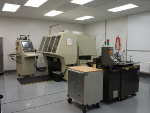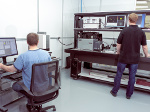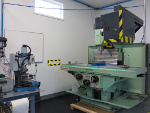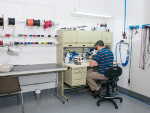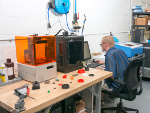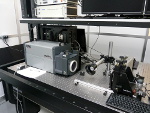DFC has over 6,000 ft2 of engineering, prototyping, and fabrication space. We provide optical, mechanical, electronic, and software design support in addition to building prototypes and fabricating custom optical elements in house. we have several large optical tables for breadboard setups and experimentation. We can make rapid initial mechanical prototypes in house using several 3D printing platforms and a Makino 3-axis CNC mill.
Optics Lab
Distant Focus has a large collection of opto-mechanics, optics, breadboards, and electronics for optical breadboarding. For sensitive experiments we use our 36" thick, 4' x 10' damped optical table. We also have two additional large optical tables that provide ample experimental space, as well as several large mobile breadboard tables that allow experiments to be moved about the lab or to our outdoor testing area. This equipment is regularly used for calibration and testing of our projects and products. For sensative assemblies we use a laminar flow hood inside our cleanroom space to create an environment where we can safely work with bare silicon image sensors and other surfaces which must be kept free of dust particles.
500FG
The Nanotech™ 500FG is a multi-axis, deterministic, ultra-precision machining system capable of generating non-axisymmetric and axisymmetric geometries in a range of materials including optical glass, crystals, non ferrous metals, polymers, and ceramics. The machine's workpiece capacity and uncompromising flexibility allow a myriad of applications to be undertaken. These include: Conformal Optics with spherical, aspheric, cylindrical, conical, and/or give geometries; Lenses & Mold Inserts; F-Theta Lenses; Aspheric Lenses & Mirrors; Diffractive Elements; Polygons; Prisms; edging and beveling. The Nanotech™ 5OOFG's novel design, advanced control and feedback systems, reduced machine geometry errors, and enhanced structural compliance result in surfaces that typically require little or no post polishing.
Metrology
We use our Zygo Verifire™ interferometric measurement system together with our Nikon Measurescope and CMM to achieve excellent measurement precision on both optical and critical mechanical parts. We also use this metrology equipment to enable extremely accurate placement of components during assembly and calibration procedures. When standard measurement tools are unavailable or insufficient, our optical expertise allows us to build custom metrology setups using our extensive collection of stages, sensors, and lasers.
Machining Area
Distant Focus has conventional milling, grinding, and sawing capability on site for rapid-turnaround on time-critical projects and to allow us to develop innovative fabrication strategies internally. Distant Focus mechanical and electrical engineers are typically involved in our machining process, which gives us an excellent understanding of design for manufacturability. More complex designs can be fabricated on our CNC mill, and simpler parts or modifications of parts can be done on our manual mill or other fabrication machinery. For final machining of mechanical parts, we rely on well-established connections with our local and remote vendors to minimize costs while maximizing the quality of our products.
Electronics Area
DFC engineers and technical staff build initial prototypes, simple circuit boards, and perform repair work on site. We keep a supply of many common components in-house, as well as oscilloscopes and signal analyzers, to quickly troubleshoot and repair systems. Our electrical team works closely with our mechanical team to design testing fixtures, custom reflow fixtures, electrical assembly fixtures, and other unique electrical / mechanical systems. The majority of our electrical fabrication is done by our vendors and our relationships with those suppliers have allowed us to accept unusual and challenging electrical assemblies.
3D Printers and Laser Engraver
To accelerate the prototyping process Distant Focus uses several different 3D printers and a laser engraver / cutting machine. This allows us to quickly test designs and make parts for initial proof-of-concept prototypes. We also combine our machining capabilities with 3D printing in order to quickly produce parts that would be impossible to print or would be more expensive to machine from raw material.



